Xylophanes rhodochlora
|
|
Updated as per
AN ANNOTATED CHECKLIST OF THE SPHINGIDAE OF BOLIVIA, October 2007
Updated as per personal communication withRodrigo Torres Núñez (Sumapaz, near Bogota, Colombia,
Updated as per personal communication with Jose Ramon Alvarez Corral (El valle, Merida, Venezuela; 90mm; 2050m; January 10, 1993); September 10, 2012
Updated as per CATE Sphingidae; September 10, 2012
Updated as per personal communication with Brian Fletcher (La Azulita, Merida, Venezuela; 2360m; March 13, 2011); March 17, 2014
Updated as per personal communication with Les Catchick (Owlet Lodge, Abra Patricia, Amazonas, Peru; 2300m; September 30, 3018); May 4, 2020
|
Xylophanes rhodochlora
Rothschild & Jordan, 1903
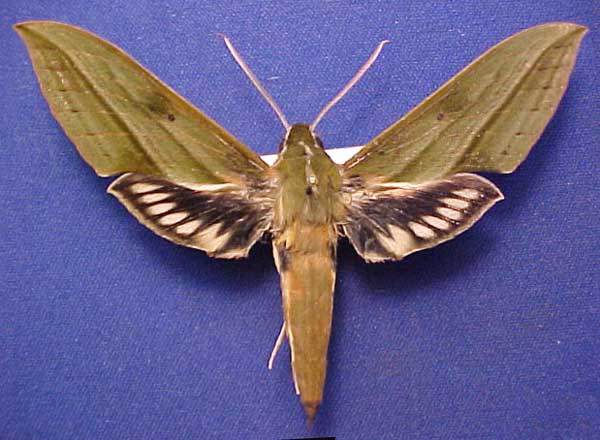
Xylophanes rhodoclora courtesy of John Vriesi.
This site has been created by Bill Oehlke.
Comments, suggestions and/or additional information are welcomed by Bill.
TAXONOMY:
Family: Sphingidae, Latreille, 1802
Subfamily: Macroglossinae, Harris, 1839
Tribe: Macroglossini, Harris, 1839
Genus: Xylophanes Hubner [1819] ...........
Species: rhodochlora Rothschild & Jordan, 1903
|
DISTRIBUTION:
Xylophanes rhodochlora (approximate wingspan: males: 90mm; females: probably larger) flies in
Peru (specimen type locality); S. Domingo, Carabaya; Amazonas: Abra Patricia: Owlet Lodge, 2300m (LC) and
Bolivia: La Paz: Murillo, Zongo;
Cochabamba; and
possibly in Colombia: Samapaz, near Bogota; and
Venezuela: El Valle, Merida, 2050m; La Azulita, Merida, 2360m.
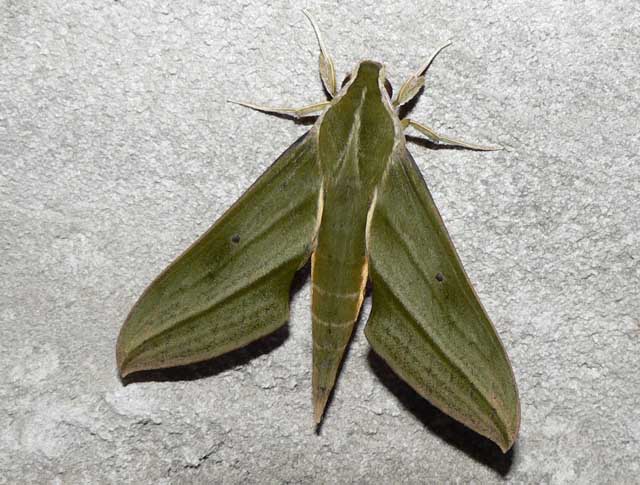
Xylophanes rhodochlora, Abra Patricia Lodge, Amazonas, Peru,
November 3, 2008, 2100m, courtesy of Bob Curry.
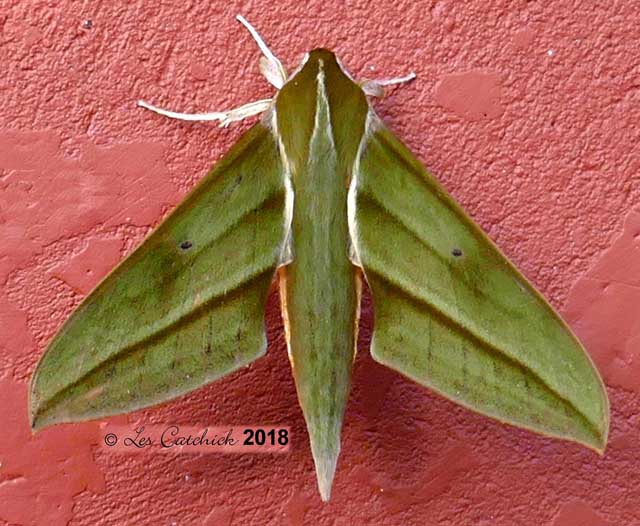
Xylophanes rhodochlora, Owlet Lodge, Abra Patricia, Amazonas, Peru,
September 30, 2018, 2300m, courtesy of Les Catchick.
"Similar to Xylophanes crotonis but forewing smaller and distinctly shorter and broader, upperside brighter green and pattern simplified.
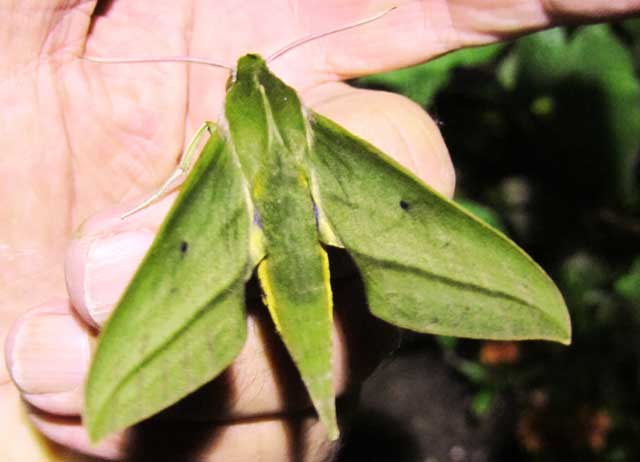
Xylophanes rhodochlora, La Azulita, Merida, Venezuela,
March 13, 2011, 2360m, courtesy of Brian Fletcher.
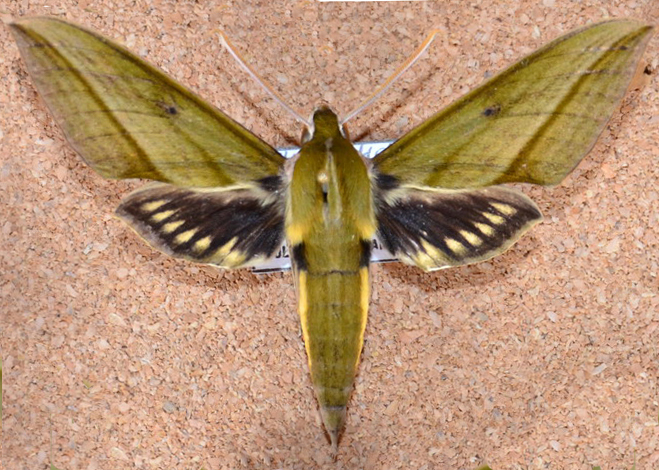
Xylophanes rhodochlora 3A, 90mm, El Valle, Merida, Venezuela,
January 10, 1993, 2050m, courtesy of Jose Ramon Alvarez Corral.
"Thorax with grey dorsal stripe, similar to that of Xylophanes aristor. Tegula edged in white along its outer (lateral), but not inner (dorsal),
margin (the reverse pattern is found in Xylophanes vagliai); no median line of grey scales. Lateral tufts at posterior edge of metanotum and base of abdomen
bright yellow (yellowish-white in Xylophanes crotonis); yellow lateral stripe narrower, shorter and paler than in
Xylophanes crotonis, and speckled with orange and brown.
Outer spur of midtibia equal to inner. Underside of thorax more orange than in
Xylophanes crotonis.
"Underside of abdomen more pink than in Xylophanes crotonis.
Forewing upperside similar to Xylophanes crotonis but only first and fourth postmedian lines conspicuous; first postmedian line straight; all other oblique lines
vestigial or absent; discal spot larger.
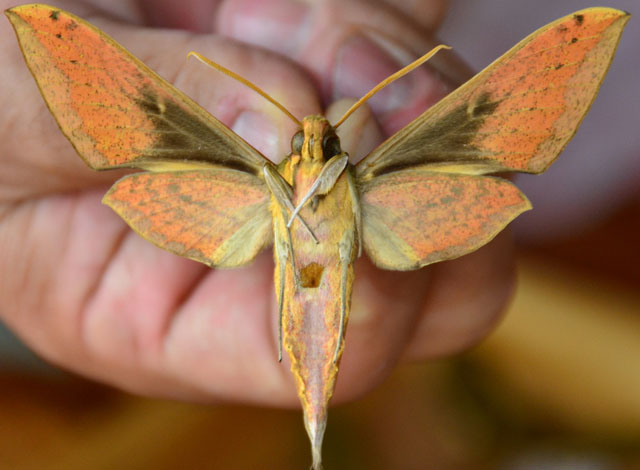
Xylophanes rhodochlora 3B, 90mm, El Valle, Merida, Venezuela,
January 10, 1993, 2050m, courtesy of Jose Ramon Alvarez Corral.
"Marginal area of forewing underside dirty grey with a scattering of black scales, very distinct from the brick-red ground colour of the rest of the wing and
delineated by a grey line that is toothed on M2 (as in Xylophanes aristor)." CATE

Xylophanes rhodochlora, Sumapaz, near Bogota, Colombia, courtesy of Rodrigo Torres Núñez,
tentative id by Bill Oehlke.

Xylophanes rhodochlora, Sumapaz, near Bogota, Colombia, courtesy of Rodrigo Torres Núñez,
tentative id by Bill Oehlke.
Hindwing "teardrop" shapes are more triangular and smaller in the specimen depicted above from Colombia as compared to
X. rhodochlora courtesy of John Vriesi, and so my
identification is tentative. I will seek other opinions on this one.
FLIGHT TIMES:
Xylophanes rhodochlora adults fly in November in Peru (BC), and possibly at other times.
ECLOSION:
Pupae probably wiggle to surface from subterranean chambers just prior to eclosion.
SCENTING AND MATING:Females call in the males with a pheromone released from a gland at the tip of the
abdomen. Males come in to lights very readily, but females are seldom taken in that way.
EGGS, LARVAE, PUPAE:
Larvae probably feed on members of the Rubiaceae or Malvaceae families.
Moths emerge approximately one-two months after larvae pupate.
Use your browser "Back" button to return to the previous page.
Goto Main Sphingidae Index
Goto Macroglossini Tribe
Goto Central American Indices
Goto Carribean Islands
Goto South American Indices
Goto U.S.A. tables







